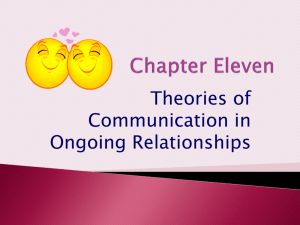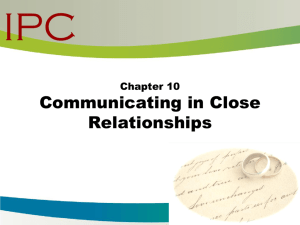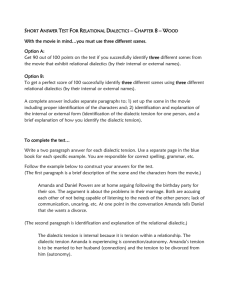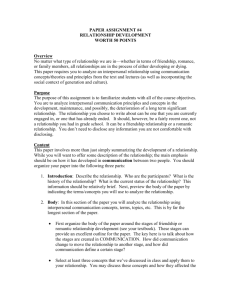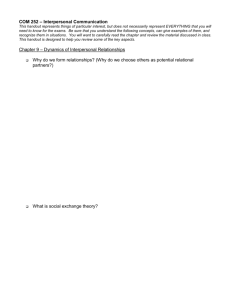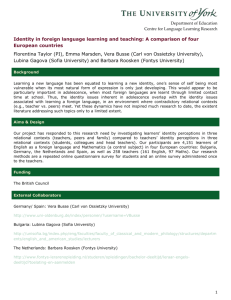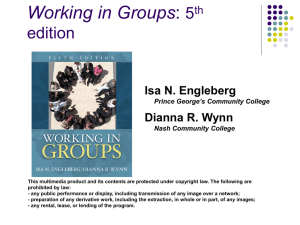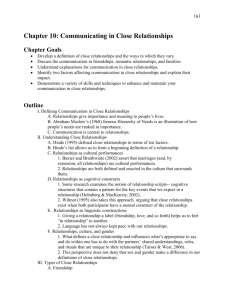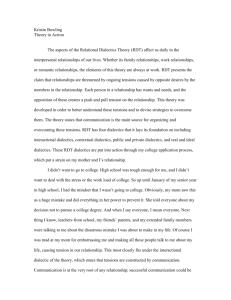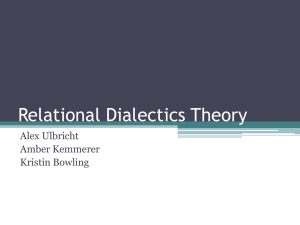Communication in Personal Relationships Personal relationships
advertisement
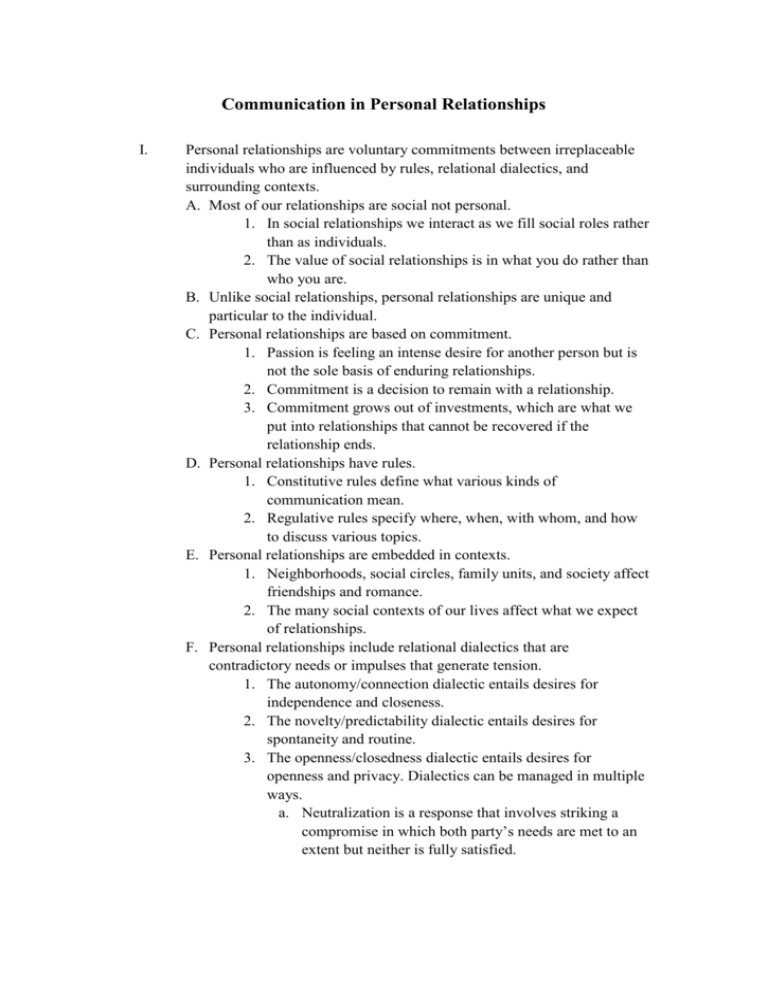
Communication in Personal Relationships I. Personal relationships are voluntary commitments between irreplaceable individuals who are influenced by rules, relational dialectics, and surrounding contexts. A. Most of our relationships are social not personal. 1. In social relationships we interact as we fill social roles rather than as individuals. 2. The value of social relationships is in what you do rather than who you are. B. Unlike social relationships, personal relationships are unique and particular to the individual. C. Personal relationships are based on commitment. 1. Passion is feeling an intense desire for another person but is not the sole basis of enduring relationships. 2. Commitment is a decision to remain with a relationship. 3. Commitment grows out of investments, which are what we put into relationships that cannot be recovered if the relationship ends. D. Personal relationships have rules. 1. Constitutive rules define what various kinds of communication mean. 2. Regulative rules specify where, when, with whom, and how to discuss various topics. E. Personal relationships are embedded in contexts. 1. Neighborhoods, social circles, family units, and society affect friendships and romance. 2. The many social contexts of our lives affect what we expect of relationships. F. Personal relationships include relational dialectics that are contradictory needs or impulses that generate tension. 1. The autonomy/connection dialectic entails desires for independence and closeness. 2. The novelty/predictability dialectic entails desires for spontaneity and routine. 3. The openness/closedness dialectic entails desires for openness and privacy. Dialectics can be managed in multiple ways. a. Neutralization is a response that involves striking a compromise in which both party’s needs are met to an extent but neither is fully satisfied. II. b. Separation is a response that satisfies one dialectical pole and ignores, neglects, and/or denies the contradictory pole. c. Segmentation is a response that assigns each pole in a dialectic to specific times or spheres of activity. d. Reframing is a complex strategic response that redefines apparently contradictory needs so they are not really oppositional. While every personal relationship develops at its own pace and in distinctive ways there are common identifiable patterns. A. A model of friendships includes six stages that may be part of relational evolution. 1. Friendship begins with role-limited interactions where we tend to rely on standard social rules and roles. 2. The second stage in friendly relations is marked by efforts to discover common ground and shared interests. 3. The third stage involves stepping beyond social roles to begin and personalize interactions. 4. Nascent friendship exists when individuals begin to think of themselves as friends or as becoming friends and when they begin to work out their own private ways of relating. 5. Stabilized friendship exists when friends are established in each other’s life and is marked by continuity and trust. 6. Waning friendship involves declines in common interest or separations often brought on by career demands or perceived circumstances, and is accompanied by a degradation in communication. B. Romantic relationships typically involve three broad phases within which there are more specific stages. 1. The escalating phase in romantic relationships includes six stages. a. The first stage is no interaction where we remain focused on ourselves as individuals. b. Invitational communication involves expressing interest in interacting with another. a. Proximity and similarity are the two greatest influences on initial attraction b. Matching hypothesis predicts that people will seek relationships with others who closely match their values, attitudes, and social background. c. Explorational communication is used to explore the possibilities for a relationship. d. Intensifying communication helps the relationship gain depth. There are six styles of loving that reflect various levels of intensification: Eros – passionate, intense and fast moving Storge – (pronounced “store-gay”) comfortable love that grows gradually to create stable companionship Ludus – playful, manipulative love Mania – loving marked by emotional extremes Agape – selfless love Pragma – goal oriented style of loving e. Revising communication involves a realistic discussion of the relationship and its future. f. Intimate bonding signals a decision to stay with the relationship permanently. 2. Navigating is an ongoing process of communicating to sustain intimacy over time in the face of multiple changes and evolving contexts. This second stage in romantic intimacy can be quite dynamic. Relationship culture is a private world of rules, understandings, meanings and patterns of interacting that established partners create for their relationships. a. It is the nucleus of an established intimate culture b. Includes management of relational dialectics and communication rules 3. The deterioration phase of relationships can be examined within the boundaries of a five-stage model. a. Intrapsychic processes trigger dyadic breakdown, where one or both partners individually think about and sometimes brood about dissatisfaction with the relationship. b. Dyadic processes, which don’t always occur, involve the breakdown of established patterns, understandings, and rules. c. Social support processes signal the likelihood of breaking up. d. Grave dressing processes, involve the decision to part ways and make sense of the ended relationship. e. Resurrection processes involve each ex-partner moving ahead to a future without the other. f. Not all patterns of relationships evolve or devolve in similar patterns and stages. At times some stages are skipped while others may be cycled through more than once. III. Four challenges to sustaining fulfilling personal relationships can be met with communication perspectives and skills. A. Dealing with distance is difficult. 1. The two greatest problems reported by partners in long-distance relationships are lack of daily small talk and unrealistic expectations for time together. 2. Partners in long-distance relationships can sustain fulfilling intimacy by finding creative ways, such as the Internet or exchanging home videos, to communicate across distance. B. Ensuring Equity in Family Relationships is challenging. 1. According to equity theory, people are happier and more satisfied with equitable relationships than inequitable ones. 2. In more dual-worker heterosexual partnerships, women carry most of the burden for homemaking and childcare. 3. Lesbian couples generally create more equitable relationships than heterosexual or gay couples. 4. Psychological responsibility involving remembering, planning, and organizing family responsibilities, is usually assumed by women. C. Resisting violence and abuse in intimate relationships is a challenge for many people. 1. The abuse cuts across socioeconomic, racial or ethnic categories. 2. The majority of violence between intimates seems to be committed by men against women, and is higher with cohabiting rather than married couples. 3. Abuse is usually not restricted to an isolated incident, but instead follows a cycle from tension to explosion, to remorse to honeymooning, and back to tension again. 4. Interpersonal and cultural communication practices can serve to normalize and promote abuse. 5. Abuse seldom stops without intervention.
